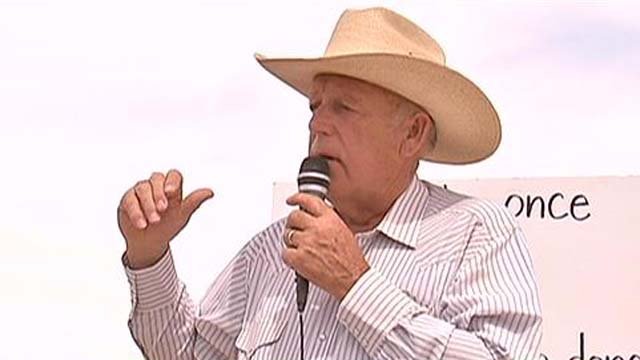Nevada rancher Cliven Bundy, accused of leading an armed standoff of 400 supporters against the federal government in 2014, was denied bail Tuesday, according to authorities.
The judge in an Oregon federal court determined that Bundy was a flight risk, said Natalie Collins, a spokeswoman for the U.S. Attorney’s Office for the District of Nevada. He is scheduled to be back in court Friday.
Last week, Bundy was charged with six counts in that 2014 showdown against federal land managers on the open range where his cattle grazed and fed.
The federal Bureau of Land Management and local authorities backed down in the face-off, halted the roundup of Bundy’s cattle and returned about 300 head to avoid any violence.
Bundy is charged conspiracy to commit an offense against the United States, assault on a federal law officer by use of a deadly and dangerous weapon, interference with commerce by extortion and obstruction of justice. He was also charged with two counts of use and carry of a firearm in relation to a crime of violence, a federal complaint said.
Cliven Bundy, 69, could spend the rest of his life in prison if convicted. The penalties of all charges added together amount to 55 years plus 32 more years that must be served consecutively under federal statute, officials said.
Arrested as he came to aid of sons
Cliven Bundy was arrested last week in Portland, where he flew in support of his sons Ammon and Ryan, who both allegedly participated in another, more recent armed standoff against federal authorities at the Malheur National Wildlife Refuge’s headquarters in Harney County, Oregon.
That 41-day standoff ended last week after the last of the holdouts surrendered to authorities.
Ammon Edward Bundy, 40, of Emmett, Idaho, and his brother Ryan C. Bundy, 43, of Bunkerville, Nevada, are among 16 people indicted in the Oregon standoff, and each of the 16 defendants face a federal felony count of conspiracy to impede officers of the United States from discharging their official duties through the use of force, intimidation or threats, the FBI said.
The 16 defendants were described by the FBI as being among “dozens of highly armed militants occupying, visiting and supplying the refuge.”
‘Lawless and violent’
In arguing against bail for Bundy, federal prosecutors portrayed Bundy as “a danger to the community,” according to court documents.
“Bundy is lawless and violent. He does not recognize federal courts — claiming they are illegitimate — does not recognize federal law, refuses to obey federal court orders, has already used force and violence against federal law enforcement officers while they were enforcing federal court orders, nearly causing catastrophic loss of life or injury to others,” federal prosecutors said in court papers filed Tuesday.
“As of the date of this hearing, he continues to violate federal court orders and continues to possess the proceeds of his illegal activities,” prosecutors said.
Bundy lives on 160 acres as a long-time resident of Bunkerville, Nevada, a sparsely populated area near the borders with Utah and Arizona, court papers said.
The Bundy Ranch is near the Virgin River a few miles from where Interstate Highway 15 crosses into Arizona, or about 90 miles northeast of Las Vegas, authorities said.
A ‘bizarre’ cattle rancher
Hundreds of thousands of acres of federal land called the Gold Butte surrounds the ranch.
“Bundy uses that entire range of land to graze his cattle unlawfully,” prosecutor said in court papers. “While Bundy claims he is a cattle rancher, his ranching operation — to the extent it can be called that — is unconventional if not bizarre.”
Bundy allows his cattle to “run wild on the public lands with little, if any, human interaction until such time he traps them and hauls them off to be sold or slaughtered for his own consumption,” prosecutors said.
Bundy allegedly doesn’t vaccinate or treat his cattle for disease and doesn’t employ cowboys to herd them, so he “has to bait them into traps in order to gather them,” prosecutors said.
“Bereft of human interaction, his cattle that manage to survive are wild, mean and ornery,” prosecutors said.
Why it took almost two years for charges
In 2014, at the time of his alleged crimes, more than 1,000 head strayed as far as 50 miles from his ranch and into the Lake Mead National Recreational Area, “getting stuck in mud, wandering onto golf courses, straying onto the freeway (causing accidents on occasion),” authorities said in documents.
In his April 2014 confrontation with federal authorities, “Bundy organized and led over 400 followers to assault BLM officers as they guarded the impoundment site, all for the purpose of getting cattle back,” prosecutors said.
“In the immediate aftermath of the April 12 assault, federal law enforcement officers were forced to abandon the impoundment site, precluding them from conducting an immediate investigation,” prosecutors said.
Out of safety concerns, local law officers allowed the gunmen and the conspirators to leave the site without facing arrest.
It took nearly took two years for authorities to finally file charges against Bundy because, prosecutors indicated, “the investigation became purely historical in nature.”
“The presence of many gunmen in and near the area of Bundy Ranch, the armed checkpoints and patrols, the presence of assault weapons in the militia camps, including (by some accounts) a .50 caliber machine gun, further increased the difficulty of conducting a physical investigation of Bundy Ranch or the impoundment site,” prosecutors added.
